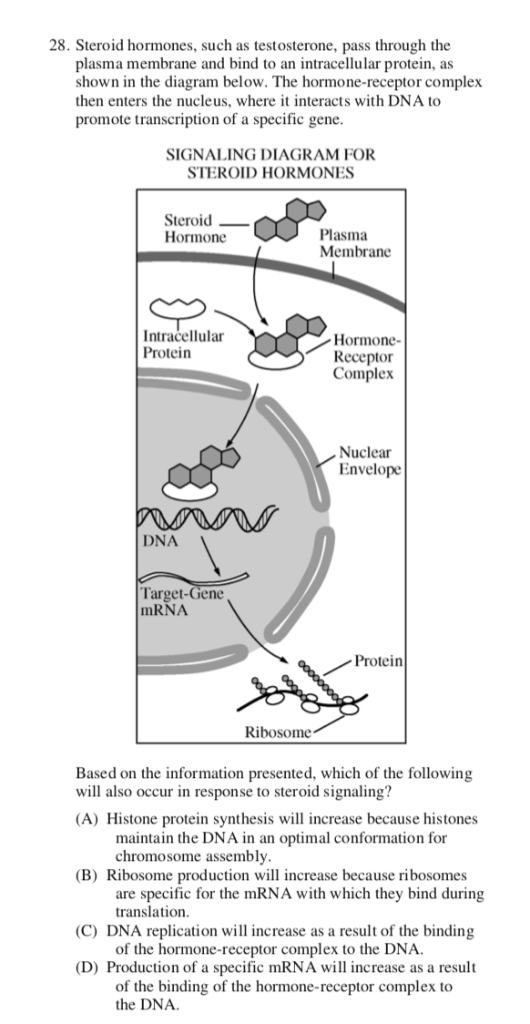Steroid Hormones Such as Testosterone Pass Through the Plasma Membrane
A The classical model. These are steroid hormones which are hydrophobic and made up of fatslipids.

Solved 28 Steroid Hormones Such As Testosterone Pass Chegg Com
The head is the hydrophilic part and the tail contains the hydrophobic fatty acids.
. The steroid hormones pass through the plasma membrane of a target cell and adhere to intracellular receptors residing in the cytoplasm or in the nucleus. Cells put the receptors for peptide hormones in their plasma membranes so the hormones can bind at the cell surface. Lipid-derived amino acid-derived and peptide.
Lipid-derived hormones are structurally similar to cholesterol and include steroid hormones such as estradiol and testosterone. They are non-polar molecules. The steroid hormone dissociates from its plasma carrier protein and diffuses across the cell membrane.
Cells express channels that let hormones flow down their concentration gradient into the cells. Illegal use and abuse of these hormones can lead to a number of negative health consequences. Corticosteroids and sex steroids.
Steroid hormones such as testosterone and estrogen are lipids so theyre hydrophobic water-fearing and can pass easily through the hydrophobic layer of the plasma membrane and enter cells. The hormone-receptor complex then enters the nucleus where it interacts with DNA to promote transcription of a specific gene. Steroid hormones such as estrogen can diffuse through the plasma membrane and bind to intracellular receptors The primary reason steroid hormones usually act slow is that _________.
Steroid hormones act on cells by passing through the cell membrane entering the nucleus binding to DNA and initiating gene transcription and protein production. Why are steroids able to diffuse across the plasma membrane. Steroid hormones such as cortisol and testosterone are derived from cholesterol which is a major.
Steroid hormones are derived from the cholesterol and eicosanoid hormones from fatty acids that compose the plasma membrane. Biology questions and answers. Intracellular receptors have DNA-binding activity meaning they can attach to specific sequences of DNA.
They are produced at very low concentrations. There are three basic types of hormones. The hormone binds to its receptor in the cytosol forming a.
Their transport protein moves them through the membrane. Steroid hormones easily diffuse through the cell membrane. Steroid hormones can be grouped into two classes.
The third class of hormones is the monoamines that are derived from aromatic amino acids like phenylalanine tyrosine and tryptophan. After gaining entry to the cell the free hormone binds to an intracellular receptor and alters gene transcription. Within those two classes are five types according to the receptors to which they bind.
Vitamin D derivatives are a sixth closely related hormone system. Question 1 - Part 1 SIGNALING DIAGRAM FOR STEROID HORMONES Steroid hormones such as testosterone pass through the plasma membrane and bind to an intracellular protein as shown in the diagram below. They are amphipathic allowing them to interact with the entire phospholipid.
Therefore they can easily pass through the cell membrane. Figure 1722 Binding of Lipid-Soluble Hormones. Steroid hormones such as testosterone pass through the plasma membrane and bind to an intracellular protein as shown in the diagram below.
- Steroid hormones such as cortisol and testosterone are derived from cholesterol which is a major component of the cell membrane. The cell signaling pathways induced by the steroid hormones regulate specific genes on the cells DNA. Three ways that a steroid hormone can interact with a cell.
A steroid hormone directly initiates the production of proteins within a target cell. Usually the ligands of intracellular receptors are small hydrophobic molecules since they must pass through the plasma membrane to get to their receptors. Amino acid-derived hormones are relatively small molecules and include the adrenal hormones epinephrine and.
Steroids to help bodybuilding Therefore they can easily pass through the cell membrane. Steroid hormones have receptors predominantly on. The hormone-receptor complex then enters the nucleus where it interacts with DNA to promote transcription of a specific gene.
The hormone-receptor complex then enters the nucleus where it interacts with DNA to promote transcription of a specific gene SIGNALING DIAGRAM FOR STEROID HORMONES. For example hydrophobic steroid hormones such as estrogen or testosterone are ligands for intracellular receptors. Anabolic steroid hormones are synthetic molecules that mimic the action of testosterone.
The steroid hormone bound to its plasma. In a membrane a bilayer of phospholipids forms the matrix of the structure the fatty acid tails of phospholipids face inside away from water whereas the phosphate group faces the outside aqueous side see image abovePhospholipids are responsible for the dynamic nature of the plasma membrane. A steroid hormone is a steroid that acts as a hormone.
When these types of hormones reach their target cells they disconnect from transport proteins and pass. They are lipid-soluble and can pass through the plasma membrane. Glucocorticoids and mineralocorticoids and androgens estrogens and progestogens.
Steroid hormones such as testosterone pass through the plasma membrane and bind to an intracellular protein as shown in the diagram below.
18 2 How Hormones Work Concepts Of Biology 1st Canadian Edition

Steroid Hormone Action Plasma Membrane Steroid Hormone Steroids

Comments
Post a Comment